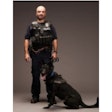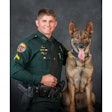When you're a member of SWAT, you know that your personal life will not be immune from disruptions. Any given hour of the day or night could find you getting the call. So when Mike Lessman's pager went off at 0430 hours on July 15, 1999, the Reno, Nev., police officer answered the call.
Told that his team was being activated to roll on a barricade situation, Lessman hung up the phone and got dressed. Less than a half hour passed before he reached the SWAT command post. The SWAT team was given an update on the events that had transpired at a nearby residence.
Twice in the early morning hours preceding the SWAT activation, patrol officers had responded to domestic disturbance calls at a home on Orovada Street. On their first visit, they found a cooperative 37-year old Glenn Sunde alone after having an argument with his girlfriend, Lisa Kelly. Kelly had left the location with her 10-month-old child, but later returned, precipitating a violent outburst from Sunde and a return call to police. When officers showed up the second time, they were met by a visibly agitated Sunde, who was wielding a large butcher knife and sporting several self-inflicted stab wounds.
In a profanity-laced tirade, Sunde advised on-scene officers that he was holding his girlfriend hostage and threatened to cut off her head. Seeing what Sunde had already done to himself, the officers had no doubt about his willingness to do so. They prudently backed off.
Attempts to negotiate with the suspect were made via telephone, with Sunde becoming more and more uncooperative. By 0300 hours, the man had discontinued talking with officers entirely and refused to answer the phone. An emergency action team was readied.
Escalating Events
As the SWAT team speculated where the suspect and his hostage might be located inside the house, officers on the perimeter alerted the team that a fire had been started inside the house. The suspect's actions were escalating events much faster than the team would have liked. Fearing that the hostage was in imminent danger, the lieutenant in charge of SWAT made the decision for an immediate entry.
The front door of the location splintered open behind the weight of a ram as tactical officers spilled into the darkened house. The first two officers breached the doorway and headed straight down the hallway in front of them. Lessman, the number four man in the stack, linked up with the officer in front of him and entered the living room to the right of the front door. Beyond the living room, they saw a kitchen and dinette area.
To counter the surge of adrenaline pulling his team deeper into the location, the assistant team leader repeated a mantra: "Walk. Walk. Walk."
His eyes straining against the darkness, Lessman peered toward the kitchen where he observed a refrigerator blocking part of its entryway. Stepping wide into the living room, he angled for a better view of the kitchen area. Just then, Lessman heard assistant team leader Greg Rea yell, "Kitchen! Kitchen! Take the kitchen!"
Lessman inched forward. Beyond the refrigerator and deeper into the kitchen was a large table that had been upended on its side. He suspected that the table was shielding someone behind it.
But the room was dark; the only illumination came from items that had been lit atop the stove in Sunde's bid to burn the place down. As Lessman entered the kitchen, he illuminated the table with the SureFire light that was mounted onto the forearm of his Heckler & Koch MP5.
As he continued to inch forward, the tops of two heads came into view beyond the table. Lessman rose up to a high ready position.
Sunde was sitting on the floor behind the table with his back against the wall. His legs were wrapped around his girlfriend Kelly's legs, pinning her to the ground directly in front of him. Sunde hugged her tight to his chest with his left arm around her neck, keeping her head firmly planted next to his own.
Given Sunde's deathgrip on Kelly, Lessman knew the hostage wasn't going anywhere. But Lessman's attention was concentrated on the object in Sunde's right hand—a large butcher knife.
Drop the Knife!
Lessman entered the kitchen and ordered Sunde to let his hostage go.
"Drop the knife! Drop the knife!"
Then, to his fellow tactical officers, Lessman yelled, "I've got him in here! I've got him in here!"
Later, Lessman would reflect that he should have been more specific and said, "I've got him in the kitchen."
But for Officer Darren Swetkovich there was no doubt. When Swetkovich saw his teammate move his MP5 to high ready, he realized that Lessman had the suspect.
Swetkovich came up shoulder to shoulder with Lessman. Both officers gave Sunde several more commands to drop the knife and let the girl go. But Sunde was hardly contrite.
"Get the f__k out of my house!" he yelled, and Lessman saw him plunge the knife downward. But Lessman's perspective didn't allow him to discern whether he was hitting himself or the hostage, a reality that also prevented him from taking a shot. Taking a half step further, Lessman gained a better view of what lay beyond the table.
[PAGEBREAK]
Kelly appeared to be unharmed. But Sunde's violent intentions were not in question and Lessman knew it was only a matter of time, perhaps seconds.
With his H&K MP5 pre-selected for semi-auto and his finger squeezing back on the trigger, Lessman zeroed in on Sunde's nose. A single thought occupied his mind. I'm not going to let this guy kill her.
He gave Sunde one more command.
"Let her go. Drop the knife."
Lessman saw Sunde raise the large butcher knife above Kelly as he arched her upper torso backwards, angling for optimum penetration of the knife's blade into her chest. Standing to the right of Lessman, Darren Swetkovich saw that Sunde held a smaller knife in his left hand and feared that the suspect would puncture her lung. While the two officers observed different yet simultaneous threats, both reached a similar determination at the same time.
Lessman depressed the trigger of his 9mm subgun. At the same time, Swetkovich fired his AR-15. Their actions were so synchronized that a news crew outside the location recorded the amplified reports of both guns as a single gunshot.
The two rounds tore into Sunde's skull, obliterating it. The .223 round from Swetkovich's AR-15 struck the suspect's nose, causing his head to turn toward the right. Lessman's 9mm round, traveling half as fast as the AR-15 round, struck the suspect's right cheek and exited at the nape of his neck. In a split second, Sunde went from very angry to very deceased.
Both officers rushed up to the table, seized Kelly, and pulled her over it. As they did, one of Sunde's arms remained draped over her shoulder.
Officer Dave Keller, positioned to the right of his team members, did not see the rounds fired and was left to infer that the suspect was still a threat to the victim and his fellow team members. Armed with an H&K 33, Keller hit Sunde with a three-round burst.
The officers then extricated Kelly from the scene and another SWAT officer escorted her outside.
Training and Execution
Lessman's training played a large part in helping him to perform in this life and death situation.
"It wasn't vastly different from a training exercise," he says. "There was no emotional attachment; I was very detached. I knew what I had to do, what action I needed to take to save this gal's life."
A former Simunitions trainer, Lessman believes that if you download information into officers' minds through training, they don't have to search for the answer when they come across the situation in real life. If you do that, their reaction will be "Wow, I've been here before. I've seen this scenario before."
At the same time, one shouldn't be too committed to a preconceived mindset.
"One thing we learned from the incident is to not go into a situation with a predisposed mindset of where the suspect is at," Lessman notes. "Initially, the point man and others were sure that the suspect was at the back of the house away from the fire when it wasn't the case. You need to be able to change and adapt upon entry."
Gratitude
Two weeks following the fatal shooting of her former boyfriend, Lisa Kelly delivered an appreciative message to the SWAT Team and Reno PD.
"I cannot imagine being in your shoes on the morning of July 15," Kelly wrote. "In my estimation of the circumstances, I would have to agree with your decision and your ultimate response as traumatic as the whole experience was for myself and Glenn.
"I want all of you to know I empathize with your positions. It must have been awful for those who came into the scene. I've thought of you often and will not forget that you may very well have saved my life. For that, I am truly grateful. My 10-month old daughter, Nicole, and I are doing well. My hope for our future is one of peace and love. Thank you and please accept my appreciation. I still can't believe I wasn't hit. Amazing. Sincerely, Lisa Kelly."
Such words of gratitude coupled with the successful outcome of the incident helped Lessman deal with the shooting. This was Lessman's second shooting in a little more than two years, but his first fatal. Having learned from the experience of his first shooting, Lessman surrendered his clothing and gear and went to the gym with a fellow SWAT officer. With an appropriate outlet for the adrenaline that built up during the intense confrontation, he experienced no stress-related issues as he had with his first shooting.
"To go back to duty we had to see a psychologist," he remembers. "In my mind, I saved this gal's life. If I had waited two seconds, I would regret this for the rest of my life saying, 'God, if I'd only been on the trigger two seconds sooner.' So I was fine with it. I didn't have any type of emotional distress over it just because I realize that if I didn't act, what the consequences were."
That realization gives Lessman peace of mind not only for the actions that he took that night but also for any action he knows he must take the next time he gets the call.














